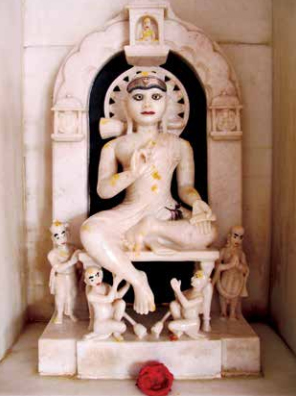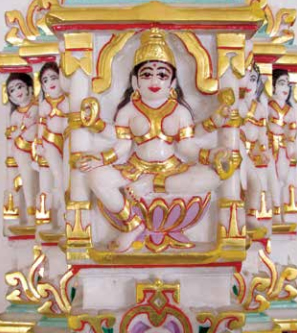
Centre of Jaina Studies Newsletter: SOAS - University of London
In Helsinki, on the last day of a very stimulating conference of the European Association for the Study of Religion,[1] scholars from around the world gathered to discuss the latest developments in the study of contemporary Jainism. With the aim of furthering the discussion on Jainism as a lived religion within the arena of religious studies, Tine Vekemans (University of Ghent) and Anja Pogacnik (University of Edinburgh) organised a bipartite panel titled Relocating Jainism, which incorporated a range of papers on Jain communities around the world into a narrative of migration, translation, and alteration.
The first session subtitled Exploring New Frontiers, Settling New Places focused on cases in which Jainism broke new ground and settled in new places, while the second session, Adapting, Re-appropriating, and Transmitting Tradition, continued with an examination of how Jainism subsequently evolved and how Jain customs and culture were negotiated and transmitted in new places of settlement.
The first three presenters took us on a journey across the worldfrom Mahārāṣṭra via Switzerland to digital derasars in the USA. The paper that set the panel in motion was 'Locating Jainism: Building a Jain Maharashtra' presented by M. Whitney Kelting (Northeastern University, USA), who focused on a case study of a newly built Jain temple in Teḷagaon, just outside Puṇe, Mahārāṣṭra. Approaching the templebuilding process in reverse (building the temple last, after all the supporting structures such as the upāśraya, bhojanśālā, and dharamśālā have already been built) and establishing new patterns of patronage through encouraging small donations instead of seeking rich patronage, the Teḷagaon Śrī Pārśva Prajñālay Tīrtha complex opened its doors for worship in 2006. As there are no places linked to auspicious events in the lives of the Jinas (kalyāṇak bhumī) in Mahārāṣṭra, Mahārāṣṭrī Jains have taken to other narratives to construct a 'Jain Mahārāṣṭra'. Instead of focussing on the historical significance of Teḷagaon, they proudly proclaim the recent transformation of wasteland and jungle into a Jain space worthy to be considered a tīrtha, a place of pilgrimage. By claiming the status of a tīrtha even before its completion, Śrī Pārśva Prajñālay Tīrtha challenged the conventional criteria and sought to establish visibility and identity for the Mahārāṣṭrī Jain community.
The next presenter, Mirjam Iseli (University of Berne, Switzerland) transported the discussion to a diasporic setting with her paper 'Jains in Switzerland: Establishment of a Supra-Denominational Community', which focussed on a group of twenty to twenty-five Jain families, who have settled in Switzerland. Given the smallness of the Swiss Jain community, there is no established Jain centre in Switzerland and people mostly meet in homes or rented halls for cultural events and bigger religious festivals (particularly for Mahāvīra Jayantī and Dīvāḷī). Due to the low numbers of Swiss Jains and the absence of religious experts ensuring a transfer of traditional knowledge, sectarian identifications have become marginalised in favour of accentuated commonalities between different branches of Jainism. Through participation in religious activities organised on a non-sectarian basis, a supra-denominational Jainism is being constructed in Switzerland.

Hemacandrācārya, Pārśvanātha Daherāsar Pāṭaṇ (Photo: Ingrid Schoon 28.12.2015)
Then our journey of exploration took us to the digital dimension. Tine Vekemans (Ghent University, Belgium) presented a paper titled 'Digital Derasars: Online Ritual in the Jain Diaspora', which presented a case of online or computer mediated rituals and their use among Jains living in the USA. Computer mediated rituals such as live darśan and online pūjā are perhaps the most intensely virtual of online activities offered to Jains. Whilst most Jains living in diaspora find accessing downloadable Jain literature, lectures, and music acceptable, many approve only conditionally of the performance of rituals through the screen of a personal computer. They see online darśan and pūjā to be acceptable for the young, the elderly, and those living far away; in essence those who have difficulty accessing local temples. Otherwise, they express dissatisfaction with the absence of sensory and social elements in computer mediated rituals. However, these online tools are regularly used in alternative ways, primarily in educating children about Jain rituals and inviting relatives and friends living abroad to participate in their religious celebrations through online livestreams.
The second session of the day, Adapting, Reappropriating, and Transmitting Tradition, focussed on particular social institutions originating in India, but finding a different life in Jain communities abroad, that is, children's religious education, youth's religious engagement, and food symbolism. Shivani Bothra (Victoria University of Wellington, New Zealand) opened the second session with 'Jain Pāṭhśālās of North America: Changes and Continuities in Contemporary Times', in which she examined the development of modern methods and curricula used in the Jain pāṭhśālās (religious classes for children) of North America. Early initiatives took the form of lectures by pundits, usually invited from India, and magazines such as the Jaina Studies Circular. These materials were then used in the first pāṭhśālās, but failed to capture the attention of children and youngsters. In 1995 the umbrella organization Jain Pāṭhśālās of North America (JPNA) was formed to provide an official curriculum and teaching materials. Bothra argued that the subsequent shifts in content and teaching methods can inform us on important contemporary trends developing within Jainism, both in India and abroad. Today, North American pāṭhśālās are typically interactive and child-centred, and the content of the classes is meant to be free from sectarian bias, as opposed to the traditional sectarian pāṭhśālās of India.
Starting from questions relating to the place of religion and religious organizations in the lives of Jain immigrants, Bindi Shah (University of Southampton, UK) compared the aims and role of Jain youth organisations oriented towards second-generation Jains in Britain (Young Jains UK (YJUK)) and North America (Young Jains of America (YJA)). Although both organizations profile themselves as places for discussion of Jainism-related topics and their relevance in contemporary society, as well as spaces for networking and social support, Shah argued that whereas in North America, YJA consistently focuses on the ethical aspects of Jainism and on community building, YJUK has experienced a shift in focus from the ethical to more philosophical and doctrinal matters. Moreover, the community-building function that is clearly present in YJA is less strong in YJUK, as the organizational landscape in the UK is more diverse and caste and language association already perform that function.
The last paper 'The Role of Food in Jain Communities in India and Abroad' by Anja Pogacnik (University of Edinburgh, UK), related how the importance of food consumption is subtly different amongst Jains in the UK and in India. Based on fieldwork in Jamnagar (Gujarat) and Leicester (England) her paper explored and contrasted the role of food in both settings. Pogacnik found that while in Gujarat the Jain food proscriptions are followed relatively rigidly and work primarily to demarcate Jains from the majority Hindu population, the Jains living in England do not follow the dietary rules as strictly. Although English Jains are still overwhelmingly vegetarian, following the Jain dietary proscriptions functions more as an indicator of an individuals' religiosity and hints at one's status in the Jain community. Pogacnik further suggested that knowledge and practice of Jain dietary proscriptions function as Bourdieu's embodied cultural capital and can in some contexts translate into symbolic capital, bringing more observant Jains prestige and authority within their religious communities
Each of the papers presented during our panel Relocating Jainism was followed by a stimulating discussion spanning everything from online dating sites and temple building in London to influences of sectarian differences in pratikramaṇa and the role of grandparents in knowledge transmission. This panel was rather unique in that it brought together researchers working on contemporary aspects of Jainism. We hope to see this network expand in the future, so that panels such as the one organised in Helsinki, will become a staple in all major conferences on religious studies.
Anja Pogacnik is a PhD student at the University of Edinburgh examining how the practice and interpretation of religion change through the process of migration and life in diaspora. Her research centres around the Jain communities in Leicester (England) and Jamnagar (Gujarat), where she explores intergenerational change in religious practice and the influence of the wider society on religious communities.
Tine Vekemans is a doctoral researcher at the Department of Languages and Cultures of Ghent University in Belgium, currently involved with the FWO-funded project Online religion in a transnational context: representing and practicing Jainism in diasporic communities. Her research interests include contemporary Jainism, the Jain diaspora, and the interactions of religion, migration, and digital media.

Yakṣī, Pārśvanātha Daherāsar Pāṭaṇ (Photo: Ingrid Schoon 28.12.2015)
 Anja Pogacnik
Anja Pogacnik